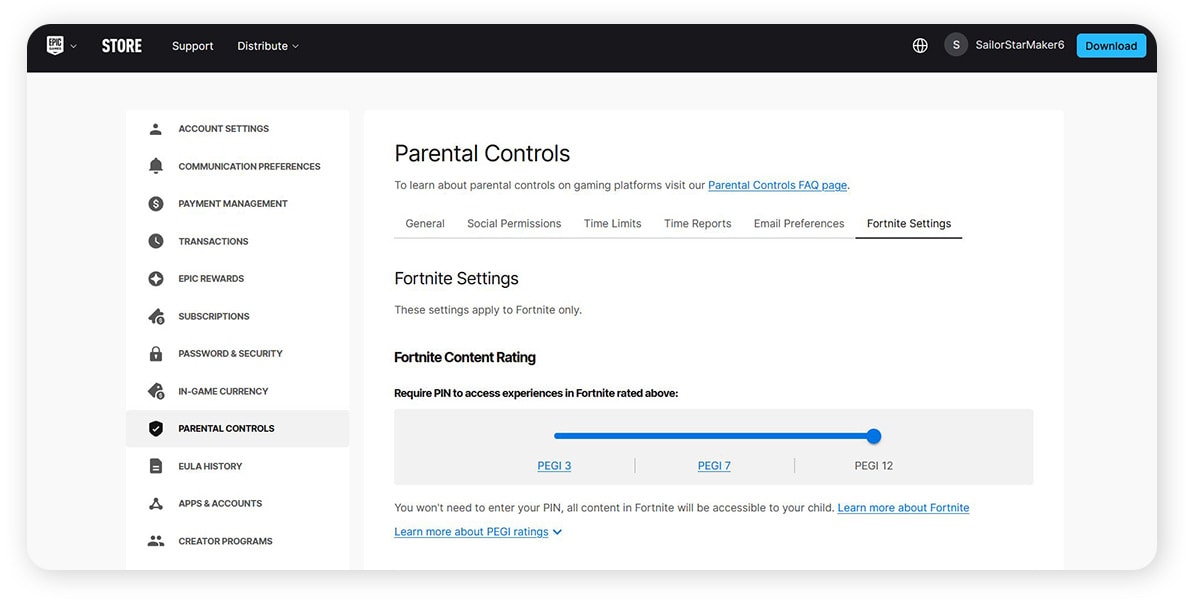Is Fortnite safe for kids? A guide to Fortnite’s age rating
Since its explosive launch in 2017, Fortnite has become a global phenomenon among kids and teens. But while the fast-paced multiplayer action and social features make it wildly popular, just how safe is Fortnite for kids? Learn about Fortnite’s age rating, key risks to watch for, and how Norton Family can help keep your child’s gaming experience safer.

Fortnite is a free-to-play online multiplayer game franchise that offers fighting, racing, and free-for-all melee modes set in a colorful, cartoon-style environment. Though the game is free to play, players can purchase weapons and skins to change their character’s arsenal and look.
Kids enjoy Fortnite’s fast-paced action and social gameplay, and it's generally considered safe. However, parents should be aware that it contains moderate cartoon violence, potential exposure to inappropriate language through voice chat, and concerns about addictive gameplay design.
What is Fortnite’s age rating?
Fortnite Battle Royale, which is the main installment in the Fortnite franchise, primarily developed by Epic Games, is rated T for Teen (13+) by the ESRB. Elements of potential concern flagged by the rating summary include violence, albeit depicted in a cartoon style, and potentially offensive or inappropriate lyrics.
These factors influenced the ESRB to rate the game as appropriate for teens but not younger children.
ESRB ratings give parents an idea of the content of a game and help them evaluate whether it’s appropriate for their child. However, despite the Teen rating, many younger kids likely play Fortnite by using a false birth date to create an account that bypasses the age restrictions.
This may be done without their parents’ consent, or as a result of their parents deciding that the content of a Teen game such as Fortnite is appropriate for their younger child and choosing to implement parental controls or screen time limits themselves.
As it’s massively grown in popularity, Fortnite has become a franchise, with numerous games under the Fortnite name. While the main game, Fortnite Battle Royale, is rated Teen, others are rated as appropriate for kids 10 and up:
- Rocket Racing (Rated E for Everyone): A fast-paced, arcade-style racing game featuring rocket-powered cars. While the racing action may sometimes get intense, Rocket Racing is non-violent and contains no inappropriate content, leading to a rating of E for all ages.
- LEGO Fortnite Odyssey (Rated E10+): A survival sandbox game in which players collect, build, and create various materials, buildings, and weapons to fight enemies. It emphasizes creativity, exploration, and building, and there are no guns present in the game. Rated E10+ for mild fantasy violence.
- Fortnite: Battle Royale (Rated T, 13+): The core Fortnite game, which most people are referring to when they say “Fortnite,” where players compete in 100-player “Battle Royale” matches to be the last one standing. Rated T for the violence of multiplayer combat featuring guns and explosions, although it’s stylized with no blood or gore.
- Fortnite: Save the World (Rated T, 13+): A cooperative shooter/survival game in which players collect supplies and defend their fort against enemies, which may include other players. Unlike other Fortnite games, Fortnite: Save the World is not free to play and requires a one-off purchase. Rated T for cartoon violence with realistic weapons.
- Fortnite Festival (Rated T, 13+): Developed by the same studio that made Rock Band and Guitar Hero, Fortnite Festival is a rhythm-based music game where players hit notes in time with popular songs. Rated T for suggestive themes in some music lyrics.
All installments in the Fortnite franchise feature the possibility of online interactions with other players, which may expose children to inappropriate language and cyberbullying. However, the ESRB is unable to rate these interactions since players’ individual experiences vary.
What are the potential risks of Fortnite?
Fortnite’s biggest safety risk is the unrated open chat feature, which allows all players in a match to communicate, potentially exposing kids to profanity, cyberbullying, or online predators. The game’s cartoon violence and battle-to-survive format may also be inappropriate for younger children.
Here are 10 potential risks of Fortnite, specifically for younger children:
- Unmoderated, unfiltered chats: Fortnite’s live chat feature is unmoderated, potentially exposing kids to inappropriate behavior. However, there is a function to report other players in-game for actions that break Epic Games’ community rules.
- Associations with gambling: Certain features of the game, such as random loot boxes players can purchase with real or in-game currency in the hopes of receiving rare items, draw parallels with gambling.
- In-app purchases: Having to pay for cool skins, weapons, or extra features means kids can spend real money on game features, which can lead to irresponsible or unauthorized spending.
- Online bullying and harassment: The open chat feature and exposure to strangers, as well as the significance of cosmetic modifications on characters in play, mean kids can be exposed to cyberbullying by peers or even adults.
- Digital predators: Since Fortnite is strongly associated with a young player base, some parents may be concerned that predators could lurk in the game searching for children to prey on.
- Potential for addiction: Fortnite revolves around a potentially addictive core gameplay loop involving rewards and achievements, with no clear endgame.
- FOMO: Time-limited items and events may pressure children to play frequently for fear of missing out on a new collectible, cosmetic, or achievement.
- Mild violence: While cartoonish, some of the violence involved in Fortnite’s gameplay may be intense and unsuitable for younger children, particularly those below the 13+ ERSB rating.
- Distraction and disruption: Kids may become distracted from schoolwork and other responsibilities or play well past their bedtime, affected by the game’s addictive features.
- No age verification enforcement: Since Fortnite lacks a robust verification mechanism, kids can just enter a false birthdate to access features that would otherwise be restricted.
Predatory behavior on Fortnite can range from cyberbullying, where kids are bullied for not having the latest skins, to outright grooming. In Kentucky, a man was convicted of grooming several children over two years after first meeting and interacting with them on Fortnite before moving to other platforms and, in some cases, meeting in person.
Dangers to kids also go beyond their immediate personal safety and well-being. In 2022, Fortnite was ordered to pay $275 million in penalties for collecting minors’ information without parental consent, and $245 million for employing “dark patterns” — deceptive game design techniques that led players to make unintended purchases.
To help prevent your kids’ vulnerability to these risks, consider giving them lessons in cyber safety and restricting their ability to make purchases or interact with strangers online to avoid reckless spending and protect them from online predators.
How is Fortnite safe for kids?
While Fortnite carries risks, it can be safe for kids with the right parental controls in place. Age-based safety settings are applied automatically, so it’s important that children enter their correct birth date at signup. Voice chat is off by default for users under 18, and those under 13 receive cabined accounts that block voice chat and purchases unless a parent grants permission.
Before letting your child play Fortnite — or any age-restricted game — consider their maturity level. The same goes for related content like livestreams or YouTube videos, which may include strong language or mature themes.
Online safety doesn’t stop with games. Teaching kids about online scams, social media safety, and responsible use of tablets and other devices is essential as they grow into more independent digital users.
How to set up Fortnite’s parental controls
Fortnite has some basic controls built in for users under 18. But if you want to tweak the settings for your child and set up parental controls beyond the default settings, you’ll need an Epic Games account. If you already have one, skip ahead to setting up a nested child’s account.
1. Set up a parental Epic Games account
If you don’t have an account, here’s how to sign up:
- Go to epicgames.com and click Sign In (top right).
- Select Create your account.
- Register by entering your date of birth, email, name, and other details.
- Agree to the terms and click Create Account.
- Verify your email when prompted.


Once you have your parent account created, you can set up a child account nested in your account. Here’s how:
- Sign out of your parental account, return to the sign-up page, and select Create your account.
- Enter your child’s date of birth. If they’re under 13, this will trigger the creation of a cabined account with parental controls.
- When prompted, enter your own email address so Epic Games can send you a parental consent request.
- Check your email for the consent request from Epic, and follow the instructions to review and approve your child’s account.
- Once approved, your child’s account will be created with limited features and parental oversight automatically enabled.


3. Configure Fortnite parental controls
Now that you have your child’s account set up, you can launch Fortnite and set up the parental controls.
1. Sign in to your child’s Epic Games account and launch Fortnite.
2. From the main menu, click the Settings gear icon, then navigate to the Parental Controls tab.


3. You’ll be prompted to create a 6-digit PIN — choose something secure and keep it private. Avoid reusing PINs from other accounts.
4. Once your PIN is set, you can customize the parental control settings to match your preferences. Make sure to save your changes before exiting.
Fortnite’s parental controls let you filter mature language, disable or limit voice and text chat, and require a PIN for purchases. You can also get weekly playtime reports by email to monitor activity. For more ideas, check out our tips on better internet safety and which parental features to enable.
Keep your kids safer online
Sadly, online threats go far beyond games like Fortnite, and your kids deserve protection everywhere. For true peace of mind, choose comprehensive software that covers all their devices, platforms, and digital risks.
That’s where Norton Family comes in. This all-in-one suite helps parents limit online distractions, monitor search and video activity, and set time limits on specific apps — all while providing weekly reports on your child’s digital behavior. Sign up for Norton Family today to get everything you need to promote safer, healthier screen time.
FAQs
Is Fortnite addictive for kids?
There are allegations that Fortnite can be addictive for kids. Its fast-paced matches, unlockable content, and constant updates create strong psychological hooks — especially when friends are online. Some parents report serious effects on sleep, eating, and daily routines. A 2023 class-action lawsuit in Canada even accused Epic Games of designing the game to be deliberately addictive. Setting up screen time limits and parental controls can help manage these risks.
Does Fortnite limit online purchases with parental controls?
Yes, Fortnite includes parental controls to help limit or block purchases. You can set a PIN to authorize any in-game spending, preventing kids from buying V-Bucks (Fortnite’s in-game currency) without permission. This is especially helpful given the game’s frequent promotions of cosmetic items that can pressure kids to spend.
Why is Fortnite so popular?
Fortnite’s popularity comes from its fast-paced gameplay, cartoon visuals, and fun social features. Kids can team up with friends online, while frequent updates, live events, and limited-time modes keep things fresh. It’s also free to play, making it easy for kids to try without having to ask their parents for money.
Fortnite is a trademark of Epic Games, Inc.
Editorial note: Our articles provide educational information for you. Our offerings may not cover or protect against every type of crime, fraud, or threat we write about. Our goal is to increase awareness about Cyber Safety. Please review complete Terms during enrollment or setup. Remember that no one can prevent all identity theft or cybercrime, and that LifeLock does not monitor all transactions at all businesses. The Norton and LifeLock brands are part of Gen Digital Inc.









Want more?
Follow us for all the latest news, tips, and updates.